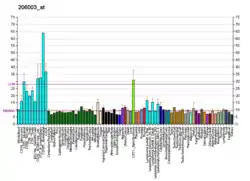CEP135
Centrosomal protein of 135 kDa is a protein that in humans is encoded by the CEP135 gene.[5][6][7] It is part of the centrosome throughout the cell cycle, being distributed in the pericentriolar material.[8] CEP135 is required for the centriolar localization of CEP250.[9]
References
- GRCh38: Ensembl release 89: ENSG00000174799 - Ensembl, May 2017
- GRCm38: Ensembl release 89: ENSMUSG00000036403 - Ensembl, May 2017
- "Human PubMed Reference:". National Center for Biotechnology Information, U.S. National Library of Medicine.
- "Mouse PubMed Reference:". National Center for Biotechnology Information, U.S. National Library of Medicine.
- Ishikawa K, Nagase T, Suyama M, Miyajima N, Tanaka A, Kotani H, Nomura N, Ohara O (Dec 1998). "Prediction of the coding sequences of unidentified human genes. X. The complete sequences of 100 new cDNA clones from brain which can code for large proteins in vitro". DNA Res. 5 (3): 169–76. doi:10.1093/dnares/5.3.169. PMID 9734811.
- Andersen JS, Wilkinson CJ, Mayor T, Mortensen P, Nigg EA, Mann M (Dec 2003). "Proteomic characterization of the human centrosome by protein correlation profiling". Nature. 426 (6966): 570–4. doi:10.1038/nature02166. PMID 14654843. S2CID 4427303.
- "Entrez Gene: CEP135 centrosomal protein 135kDa".
- Ohta T, Essner R, Ryu JH, Palazzo RE, Uetake Y, Kuriyama R (January 2002). "Characterization of Cep135, a novel coiled-coil centrosomal protein involved in microtubule organization in mammalian cells". J. Cell Biol. 156 (1): 87–99. doi:10.1083/jcb.200108088. PMC 2173569. PMID 11781336.
- Kim K, Lee S, Chang J, Rhee K (December 2008). "A novel function of CEP135 as a platform protein of C-NAP1 for its centriolar localization". Exp. Cell Res. 314 (20): 3692–700. doi:10.1016/j.yexcr.2008.09.016. PMID 18851962.
External links
- Human CEP135 genome location and CEP135 gene details page in the UCSC Genome Browser.
- PDBe-KB provides an overview of all the structure information available in the PDB for Human Centrosomal protein of 135 kDa
Further reading
- Ewing RM, Chu P, Elisma F, et al. (2007). "Large-scale mapping of human protein–protein interactions by mass spectrometry". Mol. Syst. Biol. 3 (1): 89. doi:10.1038/msb4100134. PMC 1847948. PMID 17353931.
- Olsen JV, Blagoev B, Gnad F, et al. (2006). "Global, in vivo, and site-specific phosphorylation dynamics in signaling networks". Cell. 127 (3): 635–48. doi:10.1016/j.cell.2006.09.026. PMID 17081983. S2CID 7827573.
- Colland F, Jacq X, Trouplin V, et al. (2004). "Functional Proteomics Mapping of a Human Signaling Pathway". Genome Res. 14 (7): 1324–32. doi:10.1101/gr.2334104. PMC 442148. PMID 15231748.
- Ota T, Suzuki Y, Nishikawa T, et al. (2004). "Complete sequencing and characterization of 21,243 full-length human cDNAs". Nat. Genet. 36 (1): 40–5. doi:10.1038/ng1285. PMID 14702039.
- Strausberg RL, Feingold EA, Grouse LH, et al. (2003). "Generation and initial analysis of more than 15,000 full-length human and mouse cDNA sequences". Proc. Natl. Acad. Sci. U.S.A. 99 (26): 16899–903. doi:10.1073/pnas.242603899. PMC 139241. PMID 12477932.
- Bonaldo MF, Lennon G, Soares MB (1997). "Normalization and subtraction: two approaches to facilitate gene discovery". Genome Res. 6 (9): 791–806. doi:10.1101/gr.6.9.791. PMID 8889548.
This article is issued from Wikipedia. The text is licensed under Creative Commons - Attribution - Sharealike. Additional terms may apply for the media files.




